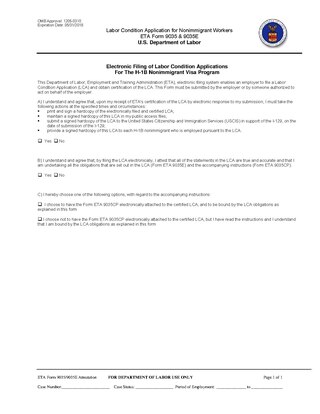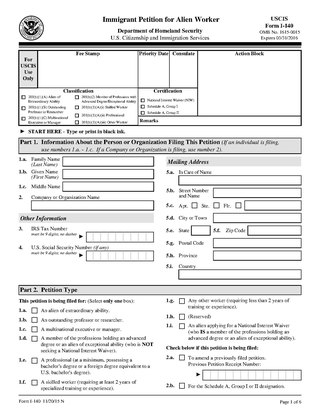Related Research Articles

A green card, known officially as a permanent resident card, is an identity document which shows that a person has permanent residency in the United States. Green card holders are formally known as lawful permanent residents (LPRs). As of 2019, there are an estimated 13.9 million green card holders, of whom 9.1 million are eligible to become United States citizens. Approximately 18,700 of them serve in the U.S. Armed Forces.
The H-1B is a visa in the United States under the Immigration and Nationality Act, section 101(a)(15)(H), that allows U.S. employers to employ foreign workers in specialty occupations. A specialty occupation requires the application of specialized knowledge and a bachelor's degree or the equivalent of work experience. The duration of stay is three years, extendable to six years, after which the visa holder can reapply. Laws limit the number of H-1B visas that are issued each year. There exist congressionally mandated caps limiting the number of H-1B visas that can be issued each fiscal year, which is 65,000 visas, and an additional 20,000 set aside for those graduating with master’s degrees or higher from a U.S. college or university. An employer must sponsor individuals for the visa. USCIS estimates there are 583,420 foreign nationals on H-1B visas as of September 30, 2019. The number of issued H-1B visas have quadrupled since the first year these visas were issued in 1991. There were 206,002 initial and continuing H-1B visas issued in 2022.
An L-1 visa is a visa document used to enter the United States for the purpose of work in L-1 status. It is a non-immigrant visa, and is valid for a relatively short amount of time, from three months to five years, based on a reciprocity schedule. With extensions, the maximum stay is seven years.
TN status is a special non-immigrant classification of foreign nationals in the United States, which offers expedited work authorization to a citizen of Canada or a national of Mexico. It was created as a result of provisions of the North American Free Trade Agreement that mandated simplified entry and employment permission for certain professionals from each of the three NAFTA member states in the other member states. The provisions of NAFTA relevant to TN status were then carried over almost verbatim to the United States–Mexico–Canada Agreement that replaced NAFTA in 2020.
Priority date is a United States immigration concept – it is the date when a principal applicant first reveals his or her intent of immigration to the US government. For family-sponsored applicants, the priority date is the date an immigration petition, filed on behalf of him or her, is received by the United States Citizenship and Immigration Services (USCIS). For employment-based immigration beneficiaries, the priority date is the date an immigration petition is filed at USCIS, under categories where a labor certification is not required, or when the United States Department of Labor receives a labor certification application, under categories where a labor certification is required. In all cases, the priority dates are not established until USCIS approves the immigration petition. The date establishes one's place in the queue for a family-sponsored or employment-based or permanent residency permit application.
An H-2A visa allows a foreign national worker into the United States for temporary agricultural work. There are several requirements of the employer in regard to this visa. The H-2A temporary agricultural program establishes a means for agricultural employers who anticipate a shortage of domestic workers to bring non-immigrant foreign workers to the U.S. to perform agricultural labor or services of a temporary or seasonal nature. In 2015 there were approximately 140,000 total temporary agricultural workers under this visa program. Terms of work can be as short as a month or two or as long as 10 months in most cases, although there are some special procedures that allow workers to stay longer than 10 months. All of these workers are covered by U.S. wage laws, workers' compensation and other standards; additionally, temporary workers and their employers are subject to the employer and/or individual mandates under the Affordable Care Act. Because of concern that guest workers might be unfairly exploited the U.S. Department of Labor Wage and Hour Division is especially vigilant in auditing and inspecting H-2A employers. H-2A employers are the only group of employers who are required to pay inbound and outbound transportation, free housing, and provide meals for their workers. H-2A agricultural employers are among the most heavily regulated and monitored employers in the United States. Unlike other guest worker programs, there is no cap on the number of H-2A visas allocated each year.

Visitors to the United States must obtain a visa from one of the U.S. diplomatic missions unless they are citizens of one of the visa-exempt or Visa Waiver Program countries.

A Form I-766 employment authorization document or EAD card, known popularly as a work permit, is a document issued by the United States Citizenship and Immigration Services (USCIS) that provides temporary employment authorization to noncitizens in the United States.
The Security Through Regularized Immigration and a Vibrant Economy Act of 2007 or STRIVE Act of 2007 is proposed United States legislation designed to address the problem of illegal immigration, introduced into the United States House of Representatives. Its supporters claim it would toughen border security, increase enforcement of and criminal penalties for illegal immigration, and establish an employment verification system to identify illegal aliens working in the United States. It would also establish new programs for both illegal aliens and new immigrant workers to achieve legal citizenship. Critics allege that the bill would turn law enforcement agencies into social welfare agencies as it would not allow CBP to detain illegal immigrants that are eligible for Z-visas and would grant amnesty to millions of illegal aliens with very few restrictions.
The EB-1 visa is a preference category for United States employment-based permanent residency. It is intended for "priority workers". Those are foreign nationals who either have "extraordinary abilities", or are "outstanding professors or researchers", and also includes "some executives and managers of foreign companies who are transferred to the US". It allows them to remain permanently in the US.
EB-2 is an immigrant visa preference category for United States employment-based permanent residency, created by the Immigration Act of 1990. The category includes "members of the professions holding advanced degrees or their equivalent", and "individuals who because of their exceptional ability in the sciences, arts, or business will substantially benefit prospectively the national economy, cultural or educational interests, or welfare of the United States, and whose services in the sciences, arts, professions, or business are sought by an employer in the United States". Applicants must generally have an approved labor certification, a job offer, and their employer must have filed an Immigrant Petition for Alien Worker with the USCIS.
The H-2B visa nonimmigrant program permits employers to hire foreign workers to come temporarily to the United States and perform temporary nonagricultural services or labor on a one-time, seasonal, peakload or intermittent basis.
EB-3 is a visa preference category for United States employment-based permanent residency. It is intended for "skilled workers", "professionals", and "other workers". Those are prospective immigrants who don't qualify for the EB-1 or EB-2 preferences. The EB-3 requirements are less stringent, but the backlog may be longer. Unlike persons with extraordinary abilities in the EB-1 category, EB-3 applicants require a sponsoring employer. There is no "self-petition" category.

The Labor Condition Application (LCA) is an application filed by prospective employers on behalf of workers applying for work authorization for the non-immigrant statuses H-1B, H-1B1 and E-3. The application is submitted to and needs to be approved by the United States Department of Labor Employment and Training Administration (DOLETA)'s Office of Foreign Labor Certification (OFLC). The form used to submit the application is ETA Form 9035.
The American Competitiveness in the 21st Century Act (AC21) was an act passed by the government of the United States in October 2000, pertaining to immigration to the United States. It was a complement to the American Competitiveness and Workforce Improvement Act that had been passed in 1998. The focus of AC21 was to change rules related to portability and caps for the H-1B visa to increase the effective number of visas available and make it easier for workers on those visas to switch jobs. Although the language of the Act references the Immigration and Naturalization Service (INS), the INS would soon be restructured and the functions of the INS referenced in AC21 would be handled by United States Citizenship and Immigration Services.
The American Competitiveness and Workforce Improvement Act (ACWIA) was an act passed by the government of the United States on October 21, 1998, pertaining to high-skilled immigration to the United States, particularly immigration through the H-1B visa, and helping improving the capabilities of the domestic workforce in the United States to reduce the need for foreign labor.

Form I-140, Immigrant Petition for Alien Worker is a form submitted to the United States Citizenship and Immigration Service (USCIS) by a prospective employer to petition an alien to work in the US on a permanent basis. This is done in the case when the worker is deemed extraordinary in some sense or when qualified workers do not exist in the US. The employer who files is called the petitioner, and the alien employee is called the beneficiary; these two can coincide in the case of a self-petitioner. The form is 6 pages long with a separate 10-page instructions document as of 2016. It is one of the USCIS immigration forms.
A National Interest Waiver is an exemption from the labor certification process and job offer requirement for advanced degree/exceptional ability workers applying for an EB-2 Visa for Immigration into the United States.
A public access file is a file that needs to be maintained by any United States employer hiring people in H-1B, H-1B1, or E-3 temporary nonimmigrant worker statuses. It is intended to include more background information related to the attestations made on the Labor Condition Application used for the Form I-129 and/or visa application that was used to acquire the nonimmigrant worker status. The file may be requested by any member of the public through telephone or email inquiries. Any member of the public requesting access to the documents must be allowed to capture the information through such means as transcription, scanning, or taking photographs, for example. It is distinguished from a private access file that contains more sensitive and confidential employee data that must be shared with the U.S. Department of Labor if they choose to investigate. Regulations governing the public access file can be found in the Code of Federal Regulations, Title 20, or more specifically, in 20 CFR 655.760.
The H-1A visa was a visa that was previously available to foreign nationals seeking temporary employment in the United States. These visas were made available to foreign nurses coming into the United States to perform services as a registered nurse in areas with a shortage of health professionals as determined by the Department of Labor. The creation of this visa was prompted by a nursing shortage.
References
- ↑ "Frequently Asked Questions Regarding Entrepreneurs and the Employment-Based Second Preference Immigrant Visa Category". Employment-Based Second Preference Immigrant Visa Category. USCIS. 2011-08-02. Archived from the original on 21 December 2013. Retrieved 27 August 2012.
- ↑ "Green Card Tracker Based on USCIS and DOS Data".